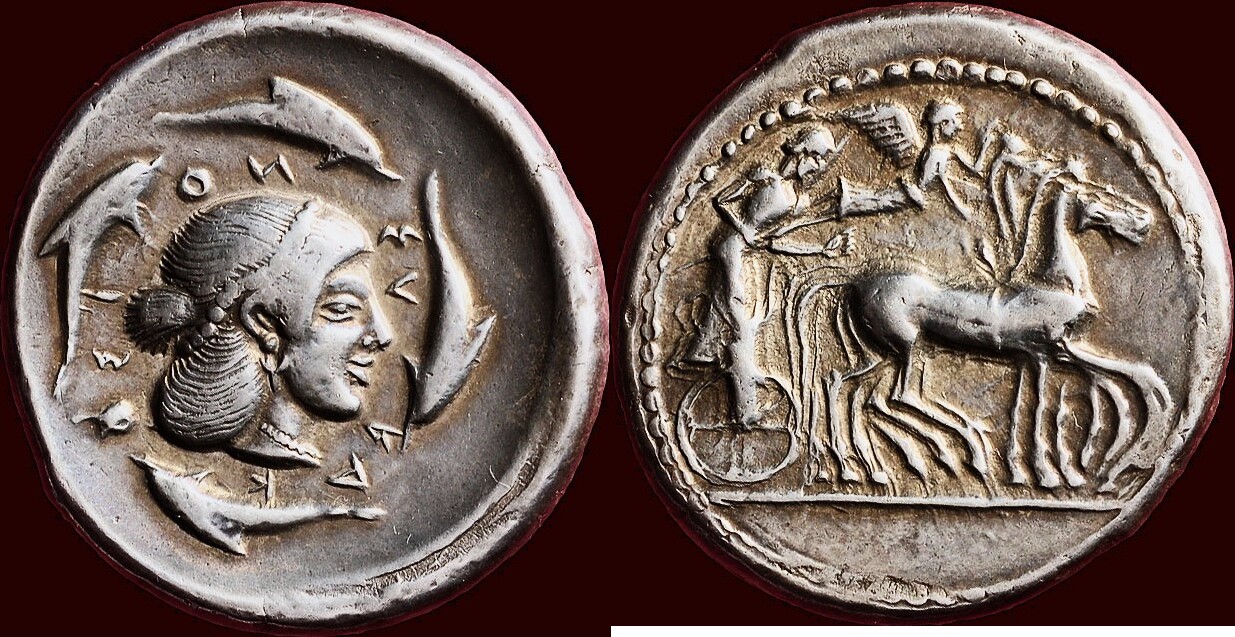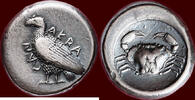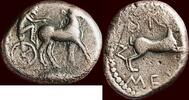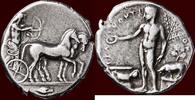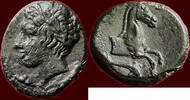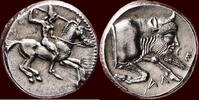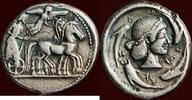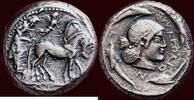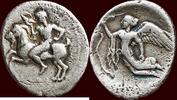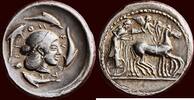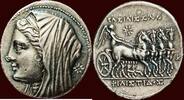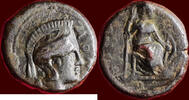MA-ID: 8434002010
Customer feedback Henzen
Schnelle Lieferung. Super Ware. Vielen Dank!
O.K.
perfekt !!!
Great coin, quick delivery, thanks!
AR Tetradrachm 475-470 BC v. Chr. SICILIA (SICILY), SYRACUSE - DEINOMENIDS - HIERON I, CA.478-467/466 - circa 475-470 BC vf / xf
Munthandel G.Henzen 

10
On MA-Shops since 10 years
7244 ratings,
100 % Positive (last 24 months)
Worldwide shipping
5,851.91 £6750,00 EUR
Import tax may be added
+ 24.27 £ shipping ( to United Kingdom )
Delivery time: 5 - 8 days
+ 24.27 £ shipping ( to United Kingdom )
| Customer Support +49 (0)2871 2180 383 |
| Payment methods |
| Wire Transfer |
weight 16,84gr. | silver Ø 26mm.
obv. Head of the water nymph Arethusa right, hair bound with
diadem-shaped band in a krobylos, wearing necklace, surrounded
by the legend ΣY - PA - K - OΣI - O И , the whole surrounded
by four clockwise swimming dolphins
rev. Slow quadriga driven right by charioteer, holding kentron and reins
above, Nike flying right to crown horses, within round border of dots.
The term ″Deinomenid″ derives from the name of Deinomenes, the father of Gelon, Hieron, Polyzalos, and Thrasyboulos. The patriarch of the Deinomenid family, however, is not responsible for the foundation of the Deinomenid tyranny. In the 6th century BC, Kleander, a member of the aristocratic class of Gela caused the downfall of the city′s oligarchy. He established the tyranny that was later handed down to his brother Hippokrates, whose ″vigorous and ruthless activities made him within seven years master of all eastern Sicily.″ Hippokrates was responsible for bringing various cities under his rule, such as Kallipolis, Leontini, Naxos, and Zankle. Gelon took up this already successful tyranny for himself after the death of Hippokrates and developed it, expanding the territory under his control. Kleander introduced the tyranny that the Deinomenids would later claim, while Hippokrates expanded this tyranny′s sphere of influence and was a model of bold ambition which Gelon and his brothers would later follow.
Circa 478 BC Hieron I became tyrant of Syracuse after the death of his brother Gelon. He led Syracuse to a significant naval victory against the Etruscans at Cumae in 474 BC, which helped to secure Greek control in the region. Hieron engaged in colonization efforts, including establishing the city of Aetna (formerly Catana) and resettling inhabitants from Naxos and Catana. Hieron was a patron of the arts, supporting poets like Pindar and Bacchylides, and hosting theatrical performances. Despite his achievements, Hieron was also known for his ruthlessness, particularly in relocating populations to consolidate his power. Hieron died in Catana in 467/466 BC.
The slow quadriga had already been introduced as the standard reverse type for Syracusan tetradrachms by the end of the sixth or the beginning of the fifth century BC, but the head of Arethusa only evolved into a full reverse type in the early fifth century BC. Previously, if she was depicted at all, she appeared within a small circular punch in the center of a main incuse square reverse punch. However, once she had developed into a full type, she made a truly dramatic appearance with with a great variety of style and hairstyle, as can be seen from this attractive piece.
cf. BMC 37 | Boehringer 324var. | SNG.Copenhagen 628var.
SNG.ANS.104var. | SNG. München 970 (same dies) | cf. Sear 914
cf. Pozzi 1208 | HGC 2, 1307 R
Very attractive specimen, well-centered and struck on a broad flan.
A rare and desirable piece. Rare.
vf/xf
obv. Head of the water nymph Arethusa right, hair bound with
diadem-shaped band in a krobylos, wearing necklace, surrounded
by the legend ΣY - PA - K - OΣI - O И , the whole surrounded
by four clockwise swimming dolphins
rev. Slow quadriga driven right by charioteer, holding kentron and reins
above, Nike flying right to crown horses, within round border of dots.
The term ″Deinomenid″ derives from the name of Deinomenes, the father of Gelon, Hieron, Polyzalos, and Thrasyboulos. The patriarch of the Deinomenid family, however, is not responsible for the foundation of the Deinomenid tyranny. In the 6th century BC, Kleander, a member of the aristocratic class of Gela caused the downfall of the city′s oligarchy. He established the tyranny that was later handed down to his brother Hippokrates, whose ″vigorous and ruthless activities made him within seven years master of all eastern Sicily.″ Hippokrates was responsible for bringing various cities under his rule, such as Kallipolis, Leontini, Naxos, and Zankle. Gelon took up this already successful tyranny for himself after the death of Hippokrates and developed it, expanding the territory under his control. Kleander introduced the tyranny that the Deinomenids would later claim, while Hippokrates expanded this tyranny′s sphere of influence and was a model of bold ambition which Gelon and his brothers would later follow.
Circa 478 BC Hieron I became tyrant of Syracuse after the death of his brother Gelon. He led Syracuse to a significant naval victory against the Etruscans at Cumae in 474 BC, which helped to secure Greek control in the region. Hieron engaged in colonization efforts, including establishing the city of Aetna (formerly Catana) and resettling inhabitants from Naxos and Catana. Hieron was a patron of the arts, supporting poets like Pindar and Bacchylides, and hosting theatrical performances. Despite his achievements, Hieron was also known for his ruthlessness, particularly in relocating populations to consolidate his power. Hieron died in Catana in 467/466 BC.
The slow quadriga had already been introduced as the standard reverse type for Syracusan tetradrachms by the end of the sixth or the beginning of the fifth century BC, but the head of Arethusa only evolved into a full reverse type in the early fifth century BC. Previously, if she was depicted at all, she appeared within a small circular punch in the center of a main incuse square reverse punch. However, once she had developed into a full type, she made a truly dramatic appearance with with a great variety of style and hairstyle, as can be seen from this attractive piece.
cf. BMC 37 | Boehringer 324var. | SNG.Copenhagen 628var.
SNG.ANS.104var. | SNG. München 970 (same dies) | cf. Sear 914
cf. Pozzi 1208 | HGC 2, 1307 R
Very attractive specimen, well-centered and struck on a broad flan.
A rare and desirable piece. Rare.
vf/xf
Please respect our order minimum of 20 Euros. For EU only IBAN payment please. Shippings to China are on risk of the buyer and only payment by bankwire or WISE. Shipping will take place within 5 days after receipt of payment. Sendings to Russia,Ukraine and Israel are not possible. Additional administration- and risk costs for PayPal & creditcard payments. No PayPal or creditcardpayments possible for orders over 10.000 euro.
| Shipping fees | ||||
|---|---|---|---|---|
| up to 86.70 £ | 86.70 £ to 433.48 £ | 433.48 £ to 866.95 £ | over 866.95 £ | |
| Argentina | 27.74 £ | 27.74 £ | 34.68 £ | 34.68 £ |
| Australia | 30.34 £ | 30.34 £ | 34.68 £ | 34.68 £ |
| Belgium | 8.24 £ | 9.54 £ | 11.27 £ | 15.61 £ |
| Brazil | 47.68 £ | 47.68 £ | 47.68 £ | 47.68 £ |
| Bulgaria | 12.14 £ | 13.87 £ | 30.34 £ | 39.01 £ |
| Chile | 43.35 £ | 43.35 £ | 43.35 £ | 43.35 £ |
| China | 34.68 £ | 34.68 £ | 43.35 £ | 43.35 £ |
| Denmark | 9.97 £ | 11.27 £ | 13.87 £ | 17.34 £ |
| Germany | 8.24 £ | 9.54 £ | 11.27 £ | 15.61 £ |
| Estonia | 11.27 £ | 12.14 £ | 13.00 £ | 21.67 £ |
| France | 8.24 £ | 9.54 £ | 13.87 £ | 21.67 £ |
| Greece | 13.00 £ | 21.67 £ | 26.01 £ | 30.34 £ |
| United Kingdom | 21.67 £ | 21.67 £ | 22.54 £ | 24.27 £ |
| Hong Kong | 34.68 £ | 34.68 £ | 43.35 £ | 43.35 £ |
| India | 30.34 £ | 30.34 £ | 34.68 £ | 43.35 £ |
| Indonesia | 30.34 £ | 30.34 £ | 34.68 £ | 34.68 £ |
| Israel | 173.39 £ | 173.39 £ | 173.39 £ | 173.39 £ |
| Japan | 34.68 £ | 34.68 £ | 34.68 £ | 34.68 £ |
| Cambodia | 56.35 £ | 56.35 £ | 56.35 £ | 56.35 £ |
| Canada | 26.01 £ | 26.01 £ | 30.34 £ | 30.34 £ |
| Liechtenstein | 17.34 £ | 17.34 £ | 21.67 £ | 21.67 £ |
| Luxembourg | 9.54 £ | 11.27 £ | 13.87 £ | 21.67 £ |
| Malaysia | 30.34 £ | 30.34 £ | 34.68 £ | 39.01 £ |
| Netherlands | 7.37 £ | 7.37 £ | 9.54 £ | 12.14 £ |
| Norway | 21.67 £ | 21.67 £ | 26.01 £ | 30.34 £ |
| Austria | 9.97 £ | 10.84 £ | 13.00 £ | 21.67 £ |
| Poland | 11.27 £ | 12.14 £ | 14.30 £ | 21.67 £ |
| Portugal | 11.27 £ | 12.14 £ | 15.61 £ | 21.67 £ |
| Romania | 13.87 £ | 15.61 £ | 21.67 £ | 30.34 £ |
| Russian Federation | 173.39 £ | 173.39 £ | 173.39 £ | 173.39 £ |
| Switzerland | 26.01 £ | 26.01 £ | 34.68 £ | 34.68 £ |
| Serbia | 21.67 £ | 21.67 £ | 26.01 £ | 30.34 £ |
| Singapore | 30.34 £ | 30.34 £ | 30.34 £ | 34.68 £ |
| Slovakia | 11.27 £ | 13.00 £ | 17.34 £ | 21.67 £ |
| Spain | 9.97 £ | 11.70 £ | 14.30 £ | 21.67 £ |
| Sri Lanka | 30.34 £ | 30.34 £ | 34.68 £ | 39.01 £ |
| Czech Republic | 10.40 £ | 12.14 £ | 15.61 £ | 21.67 £ |
| Ukraine | 173.39 £ | 173.39 £ | 173.39 £ | 173.39 £ |
| Hungary | 12.14 £ | 13.87 £ | 21.67 £ | 26.01 £ |
| United States | 27.74 £ | 27.74 £ | 30.34 £ | 34.68 £ |
| European Union | 13.00 £ | 14.74 £ | 21.67 £ | 26.01 £ |
| World | 34.68 £ | 34.68 £ | 43.35 £ | 43.35 £ |
Information
Online orders are welcome as always and will be shipped directly.
|
Seller Home | 0Shopping cart | Terms of sale | Contact | MA Terms of sale | Privacy policy | Warranty | MA-Shops New Items Copyright ® 2001-2025, MA-SHOPS Coins All Rights Reserved. Designated trademarks and brands are the property of their respective owners. |
 Buy coins with warranty
Buy coins with warranty



